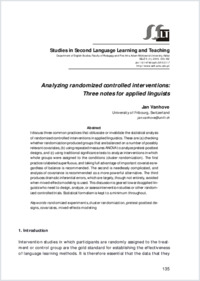Analyzing randomized controlled interventions : Three notes for applied linguists
BLE-BLL
- Vanhove, Jan University of Fribourg
-
2015
Published in:
- Studies in Second Language Learning and Teaching. - 2015, vol. 5, no. 1, p. 135-152
Linguistics and Language
Education
Language and Linguistics
randomized experiments
cluster randomization
pretest-posttest designs
covariates
mixed-effects modeling
English
I discuss three common practices that obfuscate or invalidate the statistical analysis of randomized controlled interventions in applied linguistics. These are (a) checking whether randomization produced groups that are balanced on a number of possibly relevant covariates, (b) using repeated measures ANOVA to analyze pretest-posttest designs, and (c) using traditional significance tests to analyze interventions in which whole groups were assigned to the conditions (cluster randomization). The first practice is labeled superfluous, and taking full advantage of important covariates regardless of balance is recommended. The second is needlessly complicated, and analysis of covariance is recommended as a more powerful alternative. The third produces dramatic inferential errors, which are largely, though not entirely, avoided when mixed-effects modeling is used. This discussion is geared towards applied linguists who need to design, analyze, or assess intervention studies or other randomized controlled trials. Statistical formalism is kept to a minimum throughout.
- Faculty
- Faculté des lettres et des sciences humaines
- Department
- Département de plurilinguisme et didactique des langues étrangères
- Language
-
- English
- Classification
- Language, linguistics
- License
-
License undefined
- Identifiers
-
- RERO DOC 308971
- DOI 10.14746/ssllt.2015.5.1.7
- Persistent URL
- https://folia.unifr.ch/unifr/documents/306514
Statistics
Document views: 100
File downloads:
- Texte intégral: 135
